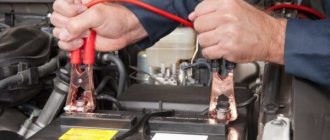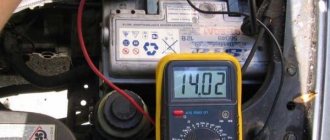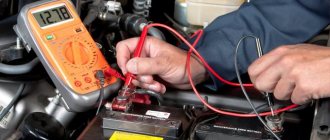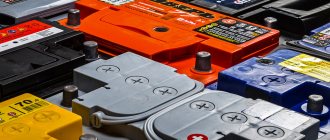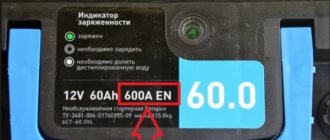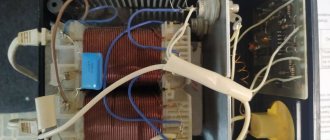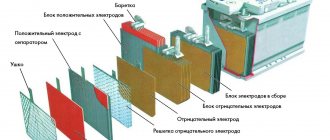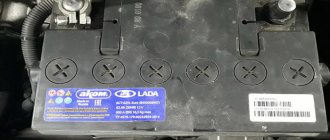Overcharging of a car battery occurs when a voltage higher than the maximum permissible - 14.6–14.8 V is applied to its terminals. This problem is most typical for older models (UAZ, “classic” VAZ) and cars with high mileage due to design features and unreliable elements electrical equipment.
Overcharging is possible if the generator fails or if the charger is used incorrectly. This article will help you understand why the battery is overcharging, why it is dangerous, whether a car battery can be overcharged in a working car, and how to find and eliminate the cause of overcharging.
What is battery recharging
Essentially, this is a charge above the norm, and in order to understand the topic in more detail, you must first understand what the norm is. The standard voltage at the terminals of a fully charged battery is on average 12.7V. When starting the engine, this figure drops, as a significant amount of electricity is released.
After the start, the machine’s hog network powers the generator, providing a voltage of about 14.5V. Current flows to the battery electrode plates, triggering reduction processes in the electrolyte - thus charging the battery.
If this process occurs at increased voltage (more than 20V) for a long time, the battery electrode grids begin to heat up, and the water in the jars evaporates and bubbles, which creates boiling. The concentration of sulfuric acid in the electrolyte increases, that is, its density increases.
During boiling, water breaks down into oxygen and hydrogen, and the resulting excess gas does not have time to be removed. At this stage, overcharging is especially dangerous - destruction of the battery case and even an explosion are possible.
Physico-chemical prerequisites for explosion
When charging a lead-acid battery, water is decomposed at the molecular level into hydrogen and oxygen. Some of the gases settle on the surface of the positive plates. The second part is an explosive mixture that accumulates under the battery housing cover. The mixture is extremely explosive, and therefore even the slightest spark is enough to set it on fire. Such sparks can occur between plates with positive and negative potential, as well as in places where they are connected in series.
For a car battery to explode, several negative factors must come together in a chain:
- decrease in electrolyte level in banks;
- long battery recharge;
- a clogged bypass valve, which in maintenance-free batteries is designed for emergency release of accumulated explosive gas;
- untimely battery maintenance;
- prolonged high load on the battery, followed by high current charging. If you unsuccessfully tried to start a cold engine, and then the battery exploded under the hood when lighting a cigarette, most likely, the actions developed exactly according to this scenario.
Which cars are affected by the problem?
Naturally, the probability of the battery receiving an excess charge on new foreign cars is significantly lower than on products with a significant mileage from the domestic automobile industry. However, there are a number of models where overcharging is considered a common problem.
We are talking about classic VAZ cars. Among the “classics”, this malfunction most often occurs on the “six” (VAZ 2106).
Trucks and some UAZ models are equipped with on-board voltage sensors and sometimes these sensors begin to signal an increase in the charging current between the generator and the battery (18V or more). This is not normal and may lead to rapid overcharging. However, often the problem is in the sensors themselves, which show incorrect information.
Features of the circuit
The above is a general diagram of the circuit, without details, but it is enough to understand how everything works. Now about the features of battery recharging.
The generator cannot independently regulate the parameters of the generated electricity, so the output voltage from it varies, and in a significant range, it depends on the crankshaft speed and the load in the on-board circuit. That is, the battery is essentially constantly being recharged while the generator is generating electricity.
In order for the battery to accept a charge, you need to apply a voltage to it slightly higher than the nominal value of the battery itself. The input voltage on the battery differs on different cars, but in general, this figure is in the range of 13.9-14.5 V.
How to detect overcharge
You can accurately determine that recharging is in progress using a multimeter. For this:
- Set the multimeter to DC mode at approximately 20V;
- We connect the contacts to the battery terminals (black wire for minus, red for plus);
- With the engine not running, a fully charged battery produces a voltage of 12.7V;
- We start the engine;
- If the generator is working properly, the snout is working and there are no problems in the on-board network, the multimeter should show 14.5V (+- 0.5V).
An overcharged battery is detected by external signs (oxidation of the terminals, electrolyte leaks on the case) or by data from the on-board computer. If your car does not have a built-in BC, you can purchase an external one.
You should pay attention to the interior lighting and the dashboard light. One of the first signs of overcharging is excessive brightness of the on-board equipment lamps.
Diagnostics of the relay regulator
Checking the relay regulator when charging the battery is not a complicated procedure and you can do it yourself using a multimeter.
Control is reduced to measuring the voltage at the terminals of the battery in various operating modes of the control panel. That is, we simply connect the multimeter probes to the terminals and measure the voltage first at idle, then at medium speed and then at high speed.
At idle, the normal voltage is 13.2-14.0V, at medium speeds - 13.6-14.2V, at high speeds - up to 14.5V.
If the values exceed the specified values, check and clean the charging system circuit contacts and repeat the procedure again.
If cleaning does not help, we check the relay separately (remove it from the car), but for this you will need a power supply with adjustable voltage (you can use a charger), as well as a regular 12 V lamp.
The essence of the control is this: we connect the “minus” wire from the charger to the case, and connect the “plus” wire to the output of the regulator. The lamp is connected to graphite brushes (polarity is not important).
When checking, first set the voltage on the source to 12.7 V, at which the lamp should light up. Gradually increase the value to 14.5 V. When the specified value is reached, the working regulator should operate and the lamp will go out.
If it continues to light when it exceeds 14.5V, the device is faulty and needs to be replaced.
What can constant overcharging lead to?
- During recharging, the electrolyte boils, and it partially flows out through the gas outlet holes and plugs of the cans. If the process continues long enough, the leaked sulfuric acid solution will end up on the radiator, wires, cooling hoses and body. The acid concentration is not high, but over time it will corrode some of the above.
- With a slight overcharge, the electrolyte falls on the battery case in the form of condensation on the terminals, causing them to oxidize and become covered with a green coating.
- Evaporation of the electrolyte leads to a decrease in its level in the banks, some of the electrodes are exposed, the plates overheat and the active mass falls off from them. This threatens to short circuit the cans and cause the battery to fail completely.
- Recharging at the final stage is accompanied by significant overheating, during which the electrolyte water breaks down into oxygen and hydrogen. The resulting mixture of gases may explode, with acid ending up in the engine compartment.
- Fuses and light bulbs on the dashboard and in the cabin blow out, other on-board electronics stop working (the voltage limit they can withstand does not exceed 17V). In some cases, the on-board network wires may melt and catch fire.
AGM batteries are especially sensitive to overcharging. The electrodes of such batteries are separated by matte glass separators. When heated, the electrolyte quickly evaporates from the porous glass fiber, leaving the plates dry. As a result, the active mixture crumbles and the battery becomes unusable.
Gel batteries suffer no less. With constant recharging, the gel can settle, exposing the upper part of the plates, which immediately close. After this, the battery will immediately become unusable.
Getting to the repair site
Finally, what to do if an overcharge is detected along the way and you need to get to the repair site.
If the voltage does not exceed 15 V, it is safe to continue driving, but try not to give the engine high speeds and reduce the number of switched on electrical consumers as much as possible (keep only the necessary ones).
If the overload is severe (more than 16 volts), you can first loosen the tension on the generator drive belt, which will reduce its performance (although the belt will wear out quickly).
If loosening the belt does not help and the voltage continues to jump to high values, you can turn off the generator (disconnect the wires from it). In this case, the on-board network will be powered only by the battery.
If the battery is well charged with a minimum number of charged consumers, you can drive 70-90 km, but in the future the battery will have to be well charged with a charger.
Source
Causes and solutions
Excessive battery charge occurs for the following reasons:
- Faulty generator shaft . We are talking about a situation where the regulator is working, but does not perform its functions correctly. The generator snout does not allow the onboard voltage to exceed 14.5V. A defective or faulty device supplies slightly higher currents to the vehicle network, which leads to a stable but not critical overcharge, since the voltage, as a rule, is slightly higher than the standard one.
- Non-working generator face . In such cases, electricity is supplied to the battery directly from the generator without any restrictions, and the voltage can exceed 24V, which as a result causes a significant overcharging of the battery.
- Faulty generator . If the diode bridge is damaged, the winding or armature breaks down on the housing, part of the current will flow past the snout, leading to overcharging.
- Poor contact in the circuit . A working relay perceives the resistance created by a poor contact as an increased load on the vehicle network. Trying to compensate, the regulator passes more voltage into the network, as a result the battery is recharged.
- Incorrect charging from the charger . Some older chargers are manually configured. An incorrectly selected mode leads to overcharging.
Important! You should not ignore partial failure of the generator, since the faulty part may sooner or later become completely inoperable.
The battery is sometimes deliberately overcharged in an attempt to restore functionality. This is done to increase the density of the electrolyte. Under high voltage, the temperature rises, boiling begins, water evaporates and the concentration of sulfuric acid increases.
Human factor
The sad statistics most often include battery explosions when charging from an external device. Possible reasons:
- battery charging current is too high;
- Long-lasting charge with high current with screwed caps. The plugs are designed to control the level and density of the electrolyte and to allow gas to escape during routine battery maintenance. When charging, to prevent the risk of explosion, manufacturers recommend unscrewing the plugs;
- battery recharge. If the charger does not have an automatic charging function, you need to monitor the current consumption level and the total charging time. The greatest risk of explosion is when using old chargers in which it is impossible to adequately adjust the voltage level and current strength.
How to protect your battery from overcharging
To charge the battery outside the car, you should use modern chargers with automatic voltage regulation. The functionality of budget devices is quite modest, but it is quite enough to charge the battery without any negative consequences.
The simplest and most effective way to protect a car battery from overcharging by a generator is to use an on-board computer. In some cars, the BC is installed from the factory, but if there is no built-in one, you can always purchase an external one. In addition to the battery status, the on-board computer displays a lot of other useful information.
Naturally, no equipment will save the battery from the negligence of its owner. The car requires attention, this especially applies to domestic used models. When the first signs of overcharging appear (increased lighting brightness, terminal oxidation, BC readings), measures should be taken immediately, otherwise serious repairs cannot be avoided later.
Simple rules for charging batteries
- Before charging, unscrew the plugs.
- Set the current to 1/10 of the battery capacity. For example, for a battery with a capacity of 72 a/h. charging with a current of 7.5-8 A will be the safest and most gentle in terms of battery preservation.
- Do not leave a charged battery connected to the charger for a long time (especially during accelerated charging, when a high current is forced).
Remember that when charging for a long time, explosive gas escapes through the plugs. It can be set on fire either by a cigarette brought close to it or by a spark that occurs when removing/putting on the crabs of the charger.
First maintenance is an important point for the battery.
Many car battery malfunctions are the result of improper maintenance, and in particular the very first one. To prevent battery malfunctions from causing constant stress and additional material costs, the first maintenance must be performed correctly:
- Cleaning the battery case from dirt, oil, electrolyte.
- Checking and tightening the battery fasteners in the engine compartment.
- Gently but thoroughly clean the gas outlet holes in the plugs. To do this, it is convenient to use a toothpick or a thick needle.
- Checking the condition of the wire tips going to the battery terminals, assessing the reliability of their fastening. If signs of oxidation are detected on the terminals, they are thoroughly cleaned with a wire brush and sandpaper.
- The electrolyte level is controlled using a glass tube. If topping is necessary, use only distilled water.
Important! During the second and subsequent checks, the above is added to the measurement of electrolyte density and its correction.
Self-test of the generator
The easiest way is to check the fuse. If it is in good condition, the generator and its location are inspected. The free rotation of the rotor, the integrity of the belt, wires, and housing are checked. If nothing arouses suspicion, the brushes and slip rings are checked. During operation, the brushes inevitably wear out, they can become jammed, skewed, and the grooves of the slip rings become clogged with graphite dust. A clear sign of this is excessive sparking.
There are frequent cases of complete wear or failure of both bearings and stator failure.
The most common mechanical problem with a generator is bearing wear. A sign of this malfunction is a howling or whistling sound when the unit is operating. Of course, the bearings must be replaced immediately, after first inspecting the seats. Loose drive belt tension can also cause poor generator performance. One of the signs may be a high-pitched whistle from under the hood when the car accelerates or accelerates.
To check the rotor field winding for short-circuited turns or breaks, you need to connect a multimeter, switched to resistance measurement mode, to both contact rings of the generator. Normal resistance is from 1.8 to 5 ohms. The readings below indicate the presence of a short circuit in the turns; above – direct winding break.
To check the stator windings for ground fault, they need to be disconnected from the rectifier unit. If the resistance readings given by the multimeter are infinitely large, there is no doubt that there is no contact between the stator windings and the housing (“ground”).
To check the diodes in the rectifier block, use a multimeter (after completely disconnecting it from the stator windings). The test mode is “diode test”. The positive probe is connected to the plus or minus of the rectifier, and the negative probe is connected to the phase terminal. After this, the probes are swapped. If the values of the multimeter readings differ greatly from the previous ones, the diode is working; if they do not differ, it is faulty. Another sign indicating the imminent “death” of the generator diode bridge is oxidation of the contacts, and the reason for this is overheating of the radiator.
Consequences
As I already wrote above, they discharged deeply several times and that’s it! The battery can be thrown away! The positive plates will be completely covered with salts, the density of the electrolyte will drop and will not increase. Even if you replace the electrolyte with a new one of the required density, it will not wash away the formed salts.
As many battery manufacturers assure, the maximum threshold value is 15 - 20 cycles. But I know from experience that after 10 cycles, such a battery cannot cope with its duties in winter; it will still work in summer.
The moral of the story is - do not allow such deep discharge parameters. This really kills your battery, each time you take away about 3% of the capacity.
